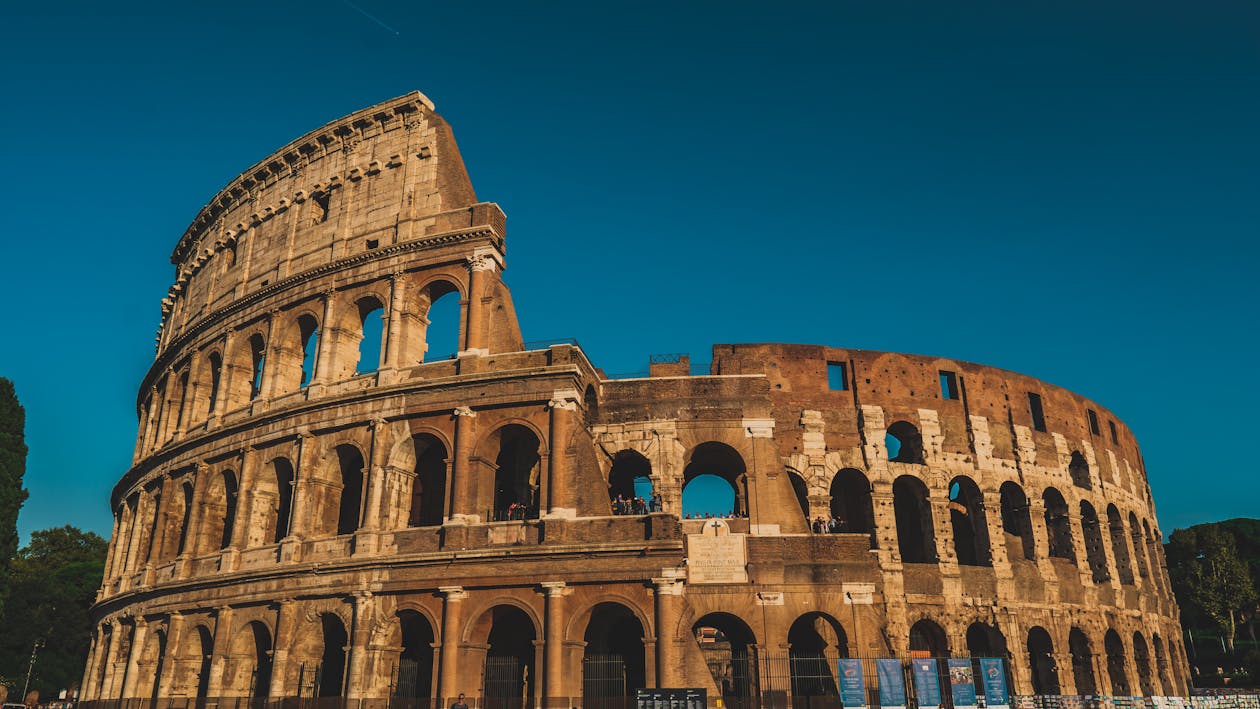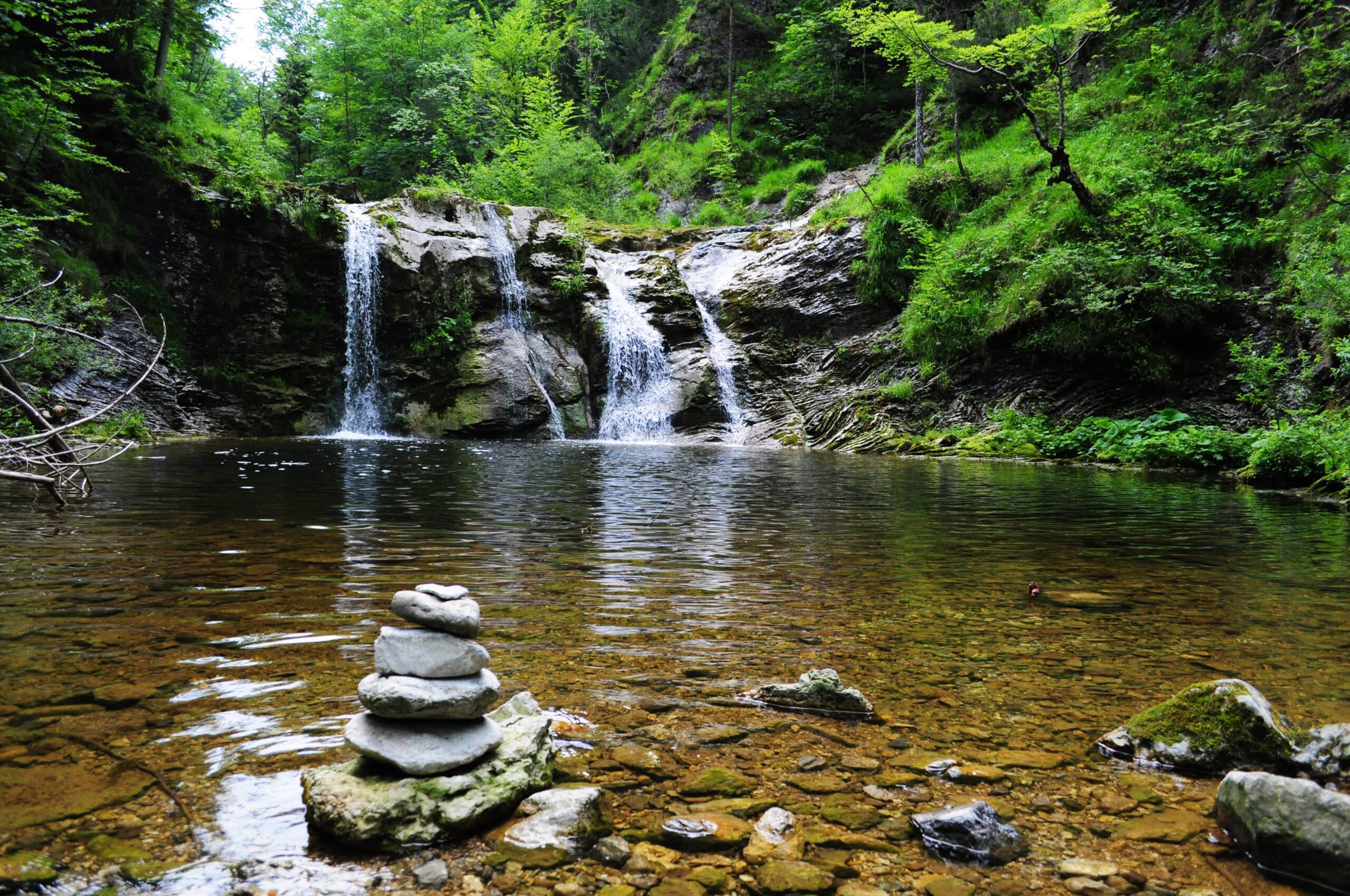Nestled in the heart of the Garhwal Himalayas, Badrinath is a sacred town in the Chamoli district of Uttarakhand, India. Known for its religious significance, Badrinath is a popular pilgrimage site for Hindus and also attracts nature enthusiasts with its breathtaking landscapes. Beyond the iconic Badrinath temple, there are numerous places worth exploring in the surrounding region. In this guide, we will delve into 15 captivating places that promise to make your journey around Badrinath an unforgettable experience. Whether you’re embarking on the Badrinath Yatra package for a spiritual pilgrimage or seeking a nature-filled adventure, these destinations offer a diverse range of experiences that will enrich your visit to this sacred region.
1. Badrinath Temple
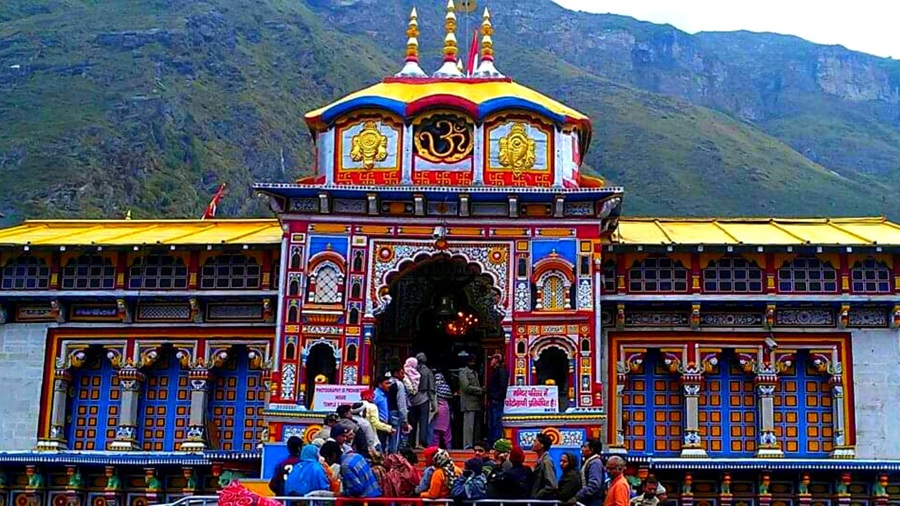
The Badrinath Temple, situated on the banks of the Alaknanda River, is a significant Hindu pilgrimage site dedicated to Lord Vishnu. Constructed in the traditional Garhwali wooden architecture, the temple’s main deity is a black stone idol of Lord Badrinarayan, intricately adorned with silver and gold. Pilgrims believe that a visit to this sacred temple washes away sins and ensures salvation. The temple is open only for a specific period each year due to the harsh weather conditions, making the pilgrimage even more challenging and spiritually rewarding.
History and Significance: The history of the Badrinath Temple dates back over a thousand years, with records suggesting its establishment by Adi Shankaracharya in the 8th century. Legends narrate that Lord Vishnu meditated in the area, and the imposing Neelkanth Peak nearby is believed to be the spot where he consumed the poison during the churning of the ocean. The temple’s significance lies not only in its religious importance but also in the breathtaking setting, surrounded by the Nar and Narayana mountain ranges, offering a serene atmosphere for introspection and devotion.
Travel Tips: Pilgrims often take a holy dip in the Tapt Kund, a natural hot spring near the temple, before entering. It’s advisable to check the annual opening and closing dates of the temple and plan the visit accordingly. The journey to Badrinath involves a scenic drive through the picturesque landscapes of the Garhwal region, providing ample opportunities for capturing the beauty of the Himalayas.
2. Mana Village
Tucked away just a few kilometers from Badrinath, Mana Village holds the distinction of being the last inhabited village on the Indian side before the Indo-China border. The village exudes a unique charm, with its rustic stone houses and narrow alleys. A short walk through the village reveals the Vyas Gufa, where the legendary sage Vedavyasa is said to have composed the Mahabharata, and the Ganesh Gufa, a cave where Lord Ganesha is believed to have transcribed the epic.
Culture and Traditions: Mana Village provides a glimpse into the traditional Garhwali way of life, with its colorful houses adorned with intricate wooden carvings. The locals, predominantly engaged in agriculture and sheep farming, warmly welcome visitors. The village also hosts the unique ‘Bhutia’ festival, celebrating the bond between humans and nature. Exploring Mana offers not only a cultural experience but also an opportunity to witness the simplicity and harmony of mountain life.
Adventure Beyond Mana: Mana serves as the base for treks to Vasudhara Falls, Bheem Pul, and other scenic spots. The trek to Vasudhara Falls unveils a breathtaking cascade surrounded by lush greenery, and Bheem Pul presents a natural rock bridge over the Saraswati River, adding an adventurous touch to the spiritual journey.
3. Vasudhara Falls
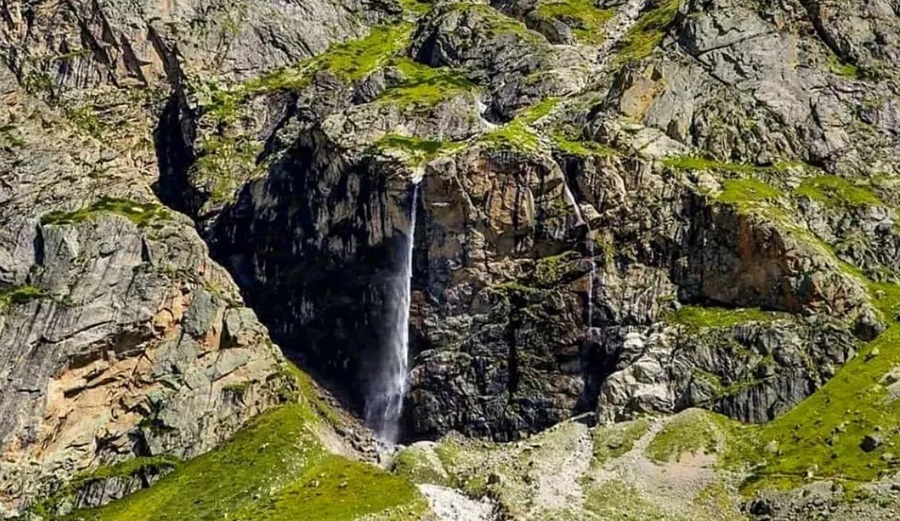
A trek of approximately 4 kilometers from Mana Village leads to the mesmerizing Vasudhara Falls. Cascading from a height of 400 feet, the waterfall is a captivating spectacle against the backdrop of snow-clad peaks. The trek itself is an adventure, taking you through alpine meadows and rocky terrain. The aura of spirituality blends seamlessly with the natural beauty, making Vasudhara Falls a sought-after destination for both pilgrims and nature enthusiasts.
Trekking Experience: The trek to Vasudhara Falls offers a moderate level of difficulty, requiring sturdy footwear and a spirit of adventure. Along the way, trekkers are treated to panoramic views of the surrounding Himalayan peaks, including Mana Parvat and Kamet. The sight of Vasudhara Falls is particularly enchanting, with the water gushing down the rocky cliffs, creating a symphony of nature that echoes through the valley.
Best Time to Visit: The ideal time to visit Vasudhara Falls is during the summer months, from May to June, when the weather is pleasant, and the trekking conditions are favorable. During this period, the meadows come alive with colorful flowers, adding a touch of vibrancy to the journey. It’s crucial to check the weather conditions and plan the trek accordingly to ensure a safe and enjoyable experience.
4. Bheem Pul
A short distance downstream from Vasudhara Falls, Bheem Pul is a natural rock bridge that spans the Saraswati River. Steeped in Hindu mythology, it is believed that Bhima, one of the Pandava brothers, placed the massive rock to help Draupadi cross the river. The impressive geological formation and the mythical connection make Bheem Pul a fascinating stop on the journey around Badrinath.
Mythological Significance: According to legend, when the Pandavas were on their way to Swargarohini, Bhima lifted a colossal rock and placed it across the river to create a bridge for Draupadi. Pilgrims and visitors are often awestruck by the sheer size of the rock and the scenic beauty of the Saraswati River flowing beneath. The spiritual significance and the awe-inspiring natural setting make Bheem Pul a unique attraction in the vicinity of Badrinath.
Access and Safety: Bheem Pul is accessible by a short trek from Mana Village, providing an opportunity to relish the pristine surroundings. While the trek is relatively easy, it’s advisable to wear appropriate footwear and exercise caution, especially during monsoon when the trail may be slippery. The bridge itself offers a panoramic view of the river and the surrounding mountains, making it a rewarding stop for both religious and nature enthusiasts.
5. Satopanth Lake

Nestled at an altitude of about 4,600 meters, Satopanth Lake is a glacial lake surrounded by snow-capped peaks, making it a challenging yet rewarding trekking destination. The journey to Satopanth Lake is not just about reaching a high-altitude water body; it’s a spiritual and visual feast. The lake is believed to be the meditative abode of Lord Brahma, Lord Vishnu, and Lord Mahesh, according to Hindu mythology.
Trekking Adventure: The trek to Satopanth Lake is an adventure that takes you through diverse landscapes, including lush meadows, rocky terrains, and snow-covered paths. Trekkers are treated to breathtaking views of Chaukhamba, Nilkantha, and Balakun peaks along the way. The serene ambiance at the lake, surrounded by towering peaks, provides a unique sense of tranquility, making it a perfect spot for meditation and self-reflection.
Permit and Precautions: Due to the high altitude and challenging terrain, obtaining permits from the Forest Department in Joshimath is mandatory for the Satopanth Lake trek. It’s advisable to undertake this trek with an experienced guide and ensure proper acclimatization to prevent altitude sickness. The best time for the trek is during the summer months, from June to September when the weather is relatively stable and the trail is accessible.
6. Neelkanth
Standing tall at 6,597 meters, Neelkanth is a majestic peak named after Lord Shiva, known for the blue hue it takes on during certain times of the day. The trek to Neelkanth offers a challenging but rewarding experience for adventure enthusiasts. The journey takes you through dense forests, alpine meadows, and rugged terrains, offering breathtaking views of the surrounding peaks.
Spiritual Vibes: Neelkanth holds immense spiritual significance, with mythology suggesting that the peak is the place where Lord Shiva consumed the poison during the churning of the ocean. The trek to Neelkanth allows pilgrims and trekkers alike to connect with the spiritual energy of the Himalayas. The panoramic views from the summit, especially during sunrise and sunset, are nothing short of awe-inspiring, making the effort to reach the peak truly worthwhile.
Trekking Tips: The trek to Neelkanth requires a good level of fitness and acclimatization due to the high altitude. It’s essential to plan the trek with a reliable guide and ensure proper gear for the journey. The best time to undertake the Neelkanth trek is during the summer months, from May to June when the weather is relatively stable.
7. Tapt Kund
Situated just below the Badrinath Temple, Tapt Kund is a natural thermal spring with hot water believed to have medicinal properties. The name “Tapt Kund” translates to “hot pond,” and pilgrims consider bathing in its waters a purifying ritual before entering the temple. The geothermal heat emanating from the Kund adds a unique dimension to the spiritual experience in Badrinath.
Rituals and Beliefs: Devotees believe that a dip in the Tapt Kund not only cleanses the body but also purifies the soul. The water is rich in minerals, and the warmth provides a soothing respite, especially in the chilly climate of the Himalayas. The combination of spiritual significance and natural therapeutic properties makes Tapt Kund a must-visit spot for pilgrims and those seeking a rejuvenating experience.
Visiting Tips: Pilgrims are advised to adhere to the prescribed guidelines for bathing in Tapt Kund, including specific timings and rituals. The experience is especially refreshing during the early morning or late evening, allowing visitors to immerse themselves in the spiritual ambiance and witness the Badrinath Temple glowing in the soft light.
8. Charanpaduka
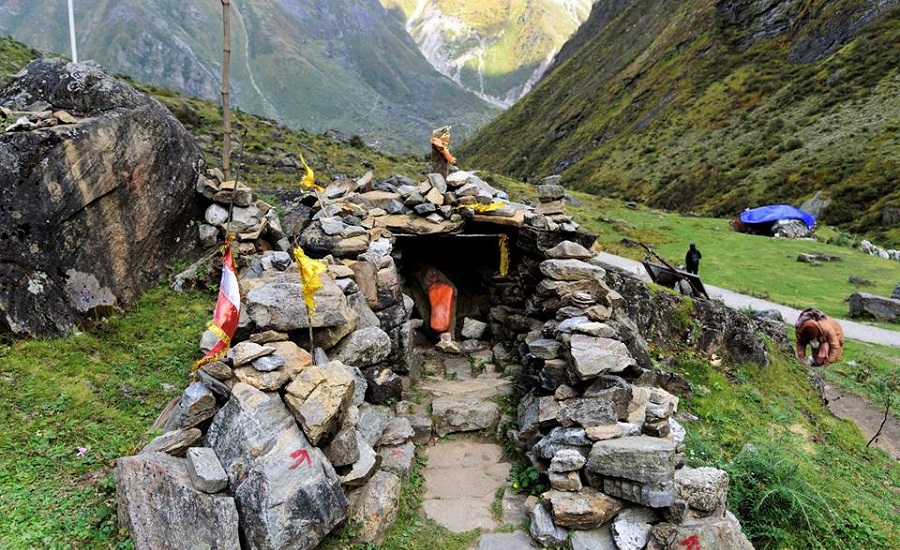
Perched at an elevation of 3,380 meters, Charanpaduka is a rock bearing what is believed to be the footprints of Lord Vishnu. The trek to Charanpaduka offers not only a spiritual journey but also panoramic views of the Neelkanth and Narayan peaks, creating a surreal backdrop. Pilgrims undertake this trek to seek the blessings of the divine footprints and soak in the mesmerizing vistas.
Scenic Trekking Experience: The trek to Charanpaduka is a moderate adventure, taking you through lush meadows and alpine landscapes. Along the way, the air is filled with the fragrance of wildflowers, enhancing the overall trekking experience. Once at Charanpaduka, the panoramic views of the surrounding peaks and the Badrinath Valley unfold, providing a sense of accomplishment and tranquility.
Photography and Reflection: Photography enthusiasts find Charanpaduka an ideal spot to capture the ethereal beauty of the Himalayas. The reflective nature of the rock surface adds to the spiritual ambiance, making it a place where one can pause, reflect, and connect with the profound energy of the mountains.
9. Narad Kund
Nestled near the Badrinath Temple, Narad Kund is a natural thermal spring considered sacred in Hindu mythology. According to legend, Sage Narada meditated at this spot, giving the Kund its name. Pilgrims believe that taking a dip in Narad Kund cleanses the body and soul, and the hot water is said to possess healing properties.
Religious Significance: Narad Kund is an integral part of the pilgrimage to Badrinath, and devotees often visit this hot spring before entering the temple. The spiritual ambiance, coupled with the therapeutic effects of the warm water, makes Narad Kund a place where religious rituals and natural elements converge, creating a unique pilgrimage experience.
Pilgrimage Rituals: Pilgrims are encouraged to participate in the rituals associated with Narad Kund, which may include bathing and performing prayers. The serene surroundings and the view of the snow-clad peaks add to the meditative atmosphere, making Narad Kund not just a stopover but a significant spiritual destination around Badrinath.
10. Joshimath
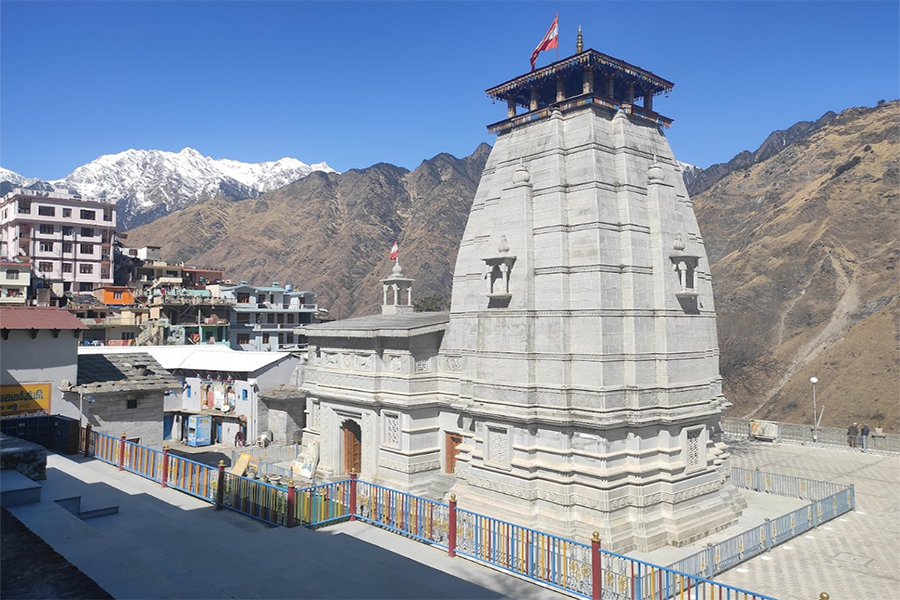
Description: Serving as the winter seat of Lord Badri, Joshimath is a picturesque town and a gateway to various trekking routes. The town is adorned with ancient temples, and the Narsingh Temple, dedicated to Lord Narasimha, is a prominent attraction. The cable car ride from Joshimath to Auli provides breathtaking views of the Himalayan peaks, making it a memorable experience for visitors.
Religious Heritage: Joshimath is not only a base for trekking adventures but also a hub of religious and cultural heritage. The town has a rich history, with Adi Shankaracharya believed to have established one of his mathas (monastic institutions) here. Pilgrims often visit the Kalpavriksha, an ancient mulberry tree with mythological significance, and the Shankaracharya Math.
Adventure Hub: Beyond its religious significance, Joshimath is a starting point for treks to the Valley of Flowers and Hemkund Sahib. The cable car ride to Auli, a popular skiing destination, offers panoramic views of the Nanda Devi range. Whether seeking spiritual solace or an adventure-filled experience, Joshimath caters to a diverse range of interests.
11. Auli
Nestled in the lap of the Garhwal Himalayas, Auli is renowned for its meadows and is a sought-after destination for skiing enthusiasts. The panoramic views of the Nanda Devi range and the oak-fringed slopes make Auli a year-round destination. In winter, the snow-covered landscape transforms into a skiing paradise, attracting adventure seekers from around the world.
Winter Wonderland: Auli’s claim to fame lies in its winter sports offerings. The well-maintained ski slopes and cable car facilities make it an ideal destination for both beginners and experienced skiers. The annual National Alpine Skiing Championship held here adds to the region’s allure as a skiing haven.
Natural Beauty and Beyond: Auli is not just about skiing; it’s also a destination for nature lovers. The meadows, dotted with vibrant flowers during the warmer months, offer a serene escape. The artificial lake in Auli, surrounded by coniferous trees, adds to the scenic beauty. Treks to Gurso Bugyal and Kwani Bugyal are popular for those seeking to explore the alpine meadows.
12. Hemkund Sahib
Perched at an altitude of 4,329 meters, Hemkund Sahib is a revered Sikh pilgrimage site surrounded by seven snow-capped peaks. The Gurudwara, dedicated to Guru Gobind Singh, is situated on the shores of the Hemkund Lake. The journey to Hemkund Sahib is a trekking adventure that traverses through lush forests and alpine meadows.
Spiritual Serenity: Hemkund Sahib holds immense spiritual significance for Sikhs, and the tranquil surroundings enhance the meditative experience. The pristine Hemkund Lake, fed by glacial waters, adds to the sacred ambiance. Pilgrims undertake the challenging trek to seek spiritual solace and connect with the divine in the lap of the Himalayas.
Trekking Challenges: The trek to Hemkund Sahib is known for its steep ascents and rocky paths. Pilgrims are advised to acclimatize properly in Joshimath before embarking on the journey. The best time to visit is during the summer months when the snow has melted, and the vibrant colors of the alpine flowers carpet the landscape.
13. Valley of Flowers
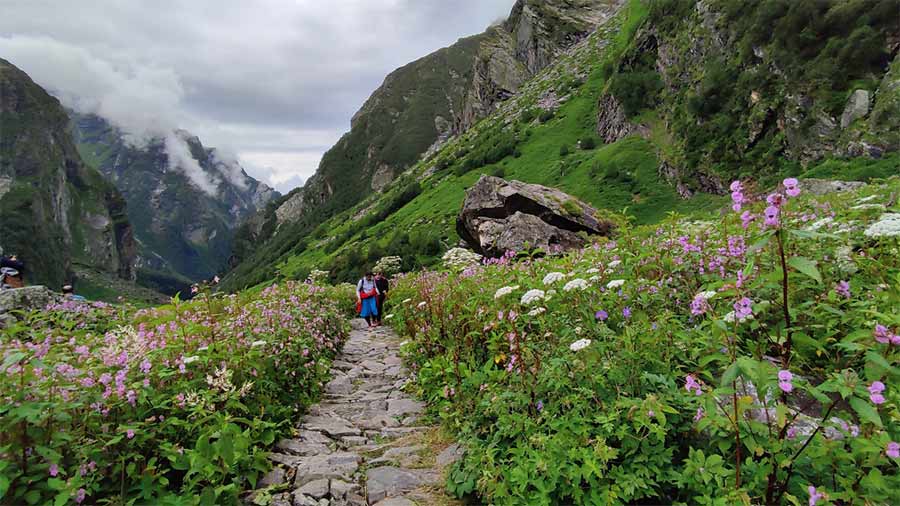
Designated as a UNESCO World Heritage Site, the Valley of Flowers is a vibrant meadow nestled at an altitude of about 3,658 meters. Accessible from Govindghat, the valley blooms with a kaleidoscope of alpine flowers during the monsoon season, creating a mesmerizing spectacle. The trek to the Valley of Flowers is a botanical and visual delight.
Botanical Paradise: The Valley of Flowers is home to numerous endemic species of flora, making it a haven for botanists and nature enthusiasts. Rare flowers like the Brahma Kamal, Blue Poppy, and Cobra Lily can be found here. The Nanda Devi National Park, of which the valley is a part, adds to the conservation efforts of this unique ecosystem.
Trekking Experience: The trek to the Valley of Flowers is moderate, offering stunning views of the surrounding mountains. The meadows are adorned with colorful flowers, and the Pushpawati River meanders through the valley, adding to the picturesque landscape. The Valley of Flowers is a must-visit for those seeking a blend of adventure, botany, and natural beauty.
14. Bhavishya Badri
One of the Panch Badri temples, Bhavishya Badri is perched at an altitude of about 2,744 meters and is believed to be the future seat of Lord Badri. The trek to Bhavishya Badri takes you through quaint villages, terraced fields, and dense forests, providing a glimpse into the traditional lifestyle of the region. The temple, surrounded by serene landscapes, holds both religious and historical significance.
Pilgrimage Through Time: The journey to Bhavishya Badri is not just a physical trek; it’s a journey through time and tradition. Pilgrims traverse ancient paths, passing by traditional wooden houses and terraced fields that have witnessed the ebb and flow of generations. The sense of antiquity and spirituality permeates the air, creating a unique pilgrimage experience.
Historical and Cultural Insights: Bhavishya Badri, like the other Badri temples, has historical connections to the Mahabharata. Legend has it that when the Kali Yuga (the present age of darkness) unfolds, Lord Badri will shift to this location. The temple’s architecture and surroundings offer insights into the cultural heritage of the region, making it not only a religious destination but also a site of historical importance.
15. Adi Badri
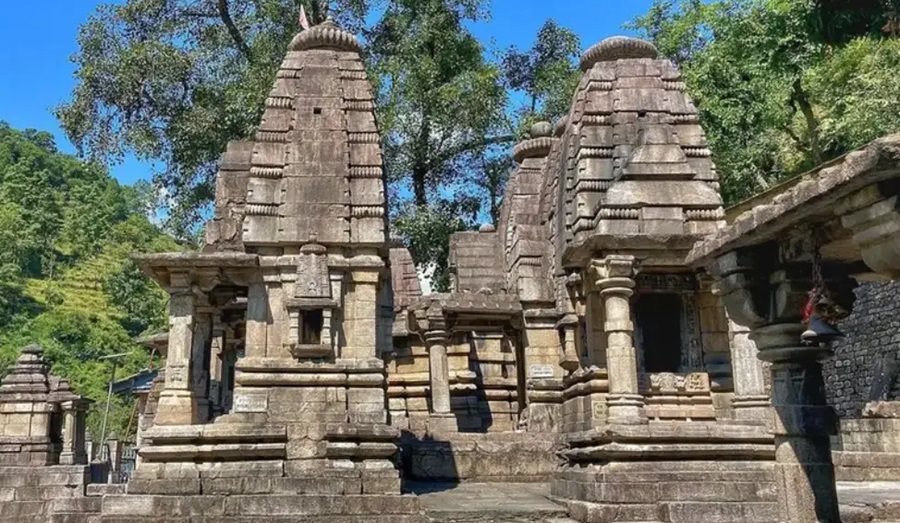
Located near Karnaprayag, Adi Badri is a complex of 16 ancient temples dedicated to Lord Vishnu. The temples, constructed in the Gupta architectural style, date back to the 7th century and showcase intricate carvings and sculptures. Adi Badri’s serene ambiance and historical significance make it a destination for both history enthusiasts and spiritual seekers.
Architectural Marvels: The temples at Adi Badri are characterized by their elegant and timeless architecture. The stone carvings depict various incarnations of Lord Vishnu, and the peaceful surroundings add to the meditative atmosphere. Despite the passage of centuries, the temples stand as a testament to the artistic and architectural prowess of the ancient builders.
Pilgrimage Circuit: Adi Badri is part of the Panch Badri pilgrimage circuit and holds importance in Hindu mythology. Pilgrims often visit Adi Badri as part of their journey to the other Badri temples. The site’s historical and religious significance, combined with its architectural beauty, makes Adi Badri a destination where spirituality and heritage converge.
Conclusion
The journey around Badrinath unfolds as a tapestry woven with spirituality, natural beauty, and historical richness. Each destination, from the sacred Badrinath Temple to the ancient Adi Badri, offers a unique facet of the Garhwal Himalayas. Whether seeking divine blessings, embarking on an adventure, or delving into the cultural heritage of the region, the places around Badrinath provide a multifaceted experience that lingers in the hearts and memories of those fortunate enough to explore this enchanting part of Uttarakhand, India.
